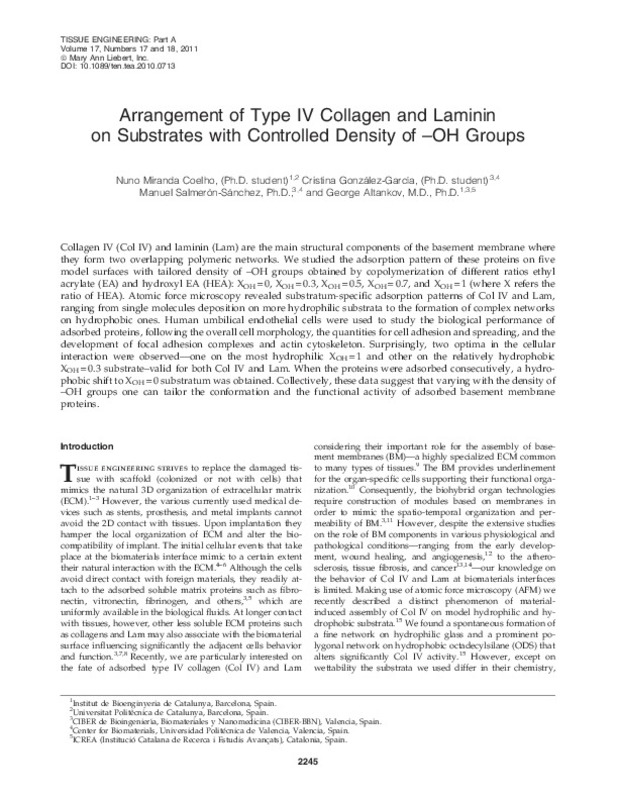Coelho, NM.; González García, C.; Salmerón Sánchez, M.; Altankov, G. (2011). Arrangement of Type IV Collagen and Laminin on Substrates with Controlled Density of ¿OH Groups. Tissue Engineering Part A. 17:2245-2257. doi:10.1089/ten.tea.2010.0713
Por favor, use este identificador para citar o enlazar este ítem: http://hdl.handle.net/10251/30116
|
Título:
|
Arrangement of Type IV Collagen and Laminin on Substrates with Controlled Density of ¿OH Groups
|
|
Autor:
|
Coelho, Nuno Miranda
González García, Cristina

 Salmerón Sánchez, Manuel
Altankov, George
Salmerón Sánchez, Manuel
Altankov, George
|
|
Entidad UPV:
|
Universitat Politècnica de València. Departamento de Física Aplicada - Departament de Física Aplicada
|
|
Fecha difusión:
|
|
|
Resumen:
|
Collagen IV (Col IV) and laminin (Lam) are the main structural components of the basement membrane where they form two overlapping polymeric networks. We studied the adsorption pattern of these proteins on five model ...[+]
Collagen IV (Col IV) and laminin (Lam) are the main structural components of the basement membrane where they form two overlapping polymeric networks. We studied the adsorption pattern of these proteins on five model surfaces with tailored density of-OH groups obtained by copolymerization of different ratios ethyl acrylate (EA) and hydroxyl EA (HEA): X OH=0, X OH=0.3, X OH=0.5, X OH=0.7, and X OH=1 (where X refers the ratio of HEA). Atomic force microscopy revealed substratum-specific adsorption patterns of Col IV and Lam, ranging from single molecules deposition on more hydrophilic substrata to the formation of complex networks on hydrophobic ones. Human umbilical endothelial cells were used to study the biological performance of adsorbed proteins, following the overall cell morphology, the quantities for cell adhesion and spreading, and the development of focal adhesion complexes and actin cytoskeleton. Surprisingly, two optima in the cellular interaction were observed-one on the most hydrophilic X OH=1 and other on the relatively hydrophobic X OH=0.3 substrate-valid for both Col IV and Lam. When the proteins were adsorbed consecutively, a hydrophobic shift to X OH=0 substratum was obtained. Collectively, these data suggest that varying with the density of-OH groups one can tailor the conformation and the functional activity of adsorbed basement membrane proteins. © 2011, Mary Ann Liebert, Inc.
[-]
|
|
Palabras clave:
|
Actin cytoskeleton
,
Adsorption patterns
,
Basement membrane
,
Biological performance
,
Cell morphology
,
Cellular interaction
,
Complex networks
,
Ethyl acrylates
,
Focal adhesions
,
Functional activities
,
Human umbilical endothelial cells
,
Laminin
,
Model surface
,
Polymeric networks
,
Single molecule
,
Structural component
,
Adsorption
,
Atomic force microscopy
,
Biological membranes
,
Buildings
,
Cell adhesion
,
Collagen
,
Endothelial cells
,
Hydrophilicity
,
Hydrophobicity
,
Substrates
,
Adhesion
|
|
Derechos de uso:
|
Reserva de todos los derechos
|
|
Fuente:
|
Tissue Engineering Part A. (issn:
1937-3341
)
|
|
DOI:
|
10.1089/ten.tea.2010.0713
|
|
Editorial:
|
Mary Ann Liebert
|
|
Versión del editor:
|
http://dx.doi.org/10.1089/ten.tea.2010.0713
|
|
Código del Proyecto:
|
info:eu-repo/grantAgreement/MICINN//MAT2009-14440-C02-02/ES/Dinamica De Las Proteinas De La Matriz En La Interfase Celula-Material/
info:eu-repo/grantAgreement/MICINN//MAT2009-14440-C02-01/ES/Dinamica De Las Proteinas De La Matriz En La Interfase Celula-Material/
|
|
Descripción:
|
This is a copy of an article published in the Diabetes Technology and Therapeutics © 2011 [copyright Mary Ann Liebert, Inc.]; Diabetes Technology and Therapeutics is available online at: http://online.liebertpub.com.
|
|
Agradecimientos:
|
AFM was performed under the technical guidance of the Microscopy Service at the Universidad Politecnica de Valencia, whose advice is greatly appreciated. The work was supported by the Spanish Ministry of Science and ...[+]
AFM was performed under the technical guidance of the Microscopy Service at the Universidad Politecnica de Valencia, whose advice is greatly appreciated. The work was supported by the Spanish Ministry of Science and Innovation through project nos. MAT2009-14440-C02-0 and MAT2009-14440-C02-02.
[-]
|
|
Tipo:
|
Artículo
|









